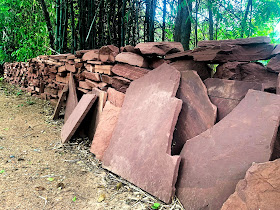Wat Bu Khi Tun วัดบุขี้ตุ่น
 Kuti Nam - กุฏิน้ำ
Kuti Nam - กุฏิน้ำThis wat is remarkable for the beautiful Kuti Nam (water cubicle) built out over the pond. This type of structure was used to store Buddhist and other texts to protect them from vermin such as rats and termites. The word "kuti" usually refers to a monk's quarters but when combined with the word for water (nam) refers to this sort of protective library.
 Bhaisajyaguru - พระพุทธเจ้าการแพทย์ (Medicine Buddha)
Bhaisajyaguru - พระพุทธเจ้าการแพทย์ (Medicine Buddha)I think that this broken bas relief is an image of Bhaisajyaguru (The Medicine Buddha). It was just sitting on the ground at Wat Bu Khi Tun. The head (see below) was not far away. This Buddha was a favorite of the Khmer King Jayavarman VII who reigned in the 12th and 13th centuries. He built a series of over 100 hospitals across the Khmer empire (including parts of present day Thailand) which were under the protection of this Buddha. Note the distinct robes, the unusual fan in the left hand and the much eroded bowl cupped in the right hand.
The Head of Bhaisajyaguru Photographic Reconstruction of Bhaisajyaguru
Photographic Reconstruction of Bhaisajyaguru

 Photographic Reconstruction of Bhaisajyaguru
Photographic Reconstruction of BhaisajyaguruThe above is my attempt to photographically recreate the image as it would have looked before it was broken into two pieces.

Wat Si Mun Burapharam - วัดสีมุมบูรพาราม
 Sandstone Buddha Image
Sandstone Buddha ImageNote the seven-headed Naga (serpent) protecting Buddha. He is sitting on a coiled Naga topped by what looks like a stylized lotus blossom. This carving is very typical of Khmer/Lopburi Buddha images which date to the 11th-13th centuries. I have no idea how old this figure is, but the area has many Khmer artifacts dating to that era.
 Mysterious Sandstone Fragments
Mysterious Sandstone FragmentsI have no idea what these are for. Sandstone is not mined in this area. Flat pieces of sandstone like this were used to make Sema Stones (see blow) and for bas relief religious carvings.
 Old Ubosot (Ordination Hall)
Old Ubosot (Ordination Hall)I believe this was rebuilt and restore to preserve the structure of an old wooden ubosot. Note the carving of Rahu above the door. Rahu is consuming the sun causing an eclipse.
 Sema Stones are used to mark the boundaries of the sacred area around an Ubosot (Ordination Hall)
Sema Stones are used to mark the boundaries of the sacred area around an Ubosot (Ordination Hall)These and the ones below are somewhat unusual because of the design; not often seen. No idea how old they are.
 Dvaravati(?) Period Buddha Image
Dvaravati(?) Period Buddha ImageI'm guessing this is a late Dvaravati Buddha image based on the fully folded legs, square jaw, flat nose, long connected earlobes and the lotus based seat.
 Pali(?) Text Written In Thai Script
Pali(?) Text Written In Thai ScriptThis is an enlarged, enhanced image of the text in the Buddha Image above.
 A Mystery
A MysteryThis may be a poor reconstruction of a Buddha image that was either broken or parts of which (the upper body) were stolen. The facial features are crude and don't fit any particular style.
 "Wat Nok" Built In BE (Buddhist Eara) 2211" - Over 350 Years Ago
"Wat Nok" Built In BE (Buddhist Eara) 2211" - Over 350 Years AgoPerhaps the original name of the wat was Wat Nok. This would have been 1668 AD during the Thai Ayuttha period. At that time the capital Siam was in Lopburi.
 Luk Nimit - ลูกนิมิต
Luk Nimit - ลูกนิมิตWhen a new ordination hall (Phra ubosot) is built Nimit stones are placed at the bottom of 9 holes dug at the eight cardinal points and the spot over which the main Buddha image will sit. Normally the Nimit stones are perfectly spherical and identical in size. These may be very old ones made at a time when such precision was either impossible or not desired.














No comments:
Post a Comment